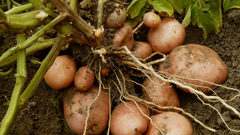🥔 How to Grow Potatoes Successfully – Step-by-Step Guide for Spring & Fall Planting
Posted May 10, 2025

Potatoes are one of the most satisfying crops to grow at home. Whether you're aiming for a bountiful summer harvest or planning a fall crop to dig just before frost, potatoes are a staple crop that’s easy, fun, and productive. 🧺
Many gardeners think they’ve missed their chance by May to plant potatoes—but you haven’t! As long as you have at least 90 frost-free days ahead, you can still grow delicious potatoes.
Let’s dig into all the steps, from chitting to harvest, and explore the best varieties by season, watering and fertilizing needs, and fall planting tips. 👩🌾
🕒 Understanding Potato Maturity Times
Before planting, choose varieties that match your growing season:
-
Short Season (Early) – 60 to 80 days
-
Best for quick crops and fall planting.
-
Examples: Yukon Gold, Red Norland, Caribe
-
-
Mid Season – 85 to 100 days
-
Great for summer harvests.
-
Examples: Kennebec, Gold Rush, Red Pontiac
-
-
Late Season – 100 to 130 days
-
Best for winter storage if planted in spring.
-
Examples: Russet Burbank, Butte, German Butterball
-
💡 For fall planting, always use short-season varieties to ensure you harvest before frost hits!
🌱 Step-by-Step: Growing Potatoes from Start to Finish
1️⃣ Chit Your Seed Potatoes (Optional but Helpful)
🧊 Chitting means letting your seed potatoes sprout before planting.
-
Place them in a bright, cool spot (around 60°F) for 1–2 weeks.
-
Let the sprouts grow ½–1 inch long.
-
This gives them a head start and leads to quicker growth after planting.
2️⃣ Prep the Soil
🪱 Potatoes love loose, well-draining, fertile soil.
-
Amend your bed with compost or aged manure.
-
Avoid fresh manure (it can cause scab).
-
Loosen soil 8–10 inches deep.
3️⃣ Plant Your Potatoes
🌿 When the soil reaches 50°F, it’s go time!
-
Cut large seed potatoes into chunks with at least 1–2 eyes each (optional if they're small).
-
Let the cuts cure for 1–2 days before planting to prevent rot.
-
Plant 4" deep and 12" apart, with rows about 30" apart.
4️⃣ Hill As They Grow
🧺 This is key for healthy potatoes and higher yields!
-
When plants are 6–8" tall, mound soil or straw around them, leaving just a few inches showing.
-
Repeat every couple of weeks until the hills are 10–12" tall.
This keeps tubers from turning green and boosts production.
5️⃣ Watering Wisely
💧 Potatoes need consistent moisture—especially as tubers begin to form.
-
Start with moderate watering.
-
Increase water as the plants grow—about 1–2 inches per week.
-
Once the plants begin to yellow or fall over at the end of the season, reduce water to help the skins cure and prevent rot.
6️⃣ Fertilize for Success
🌿 Feed your potatoes for best results:
-
Mix in an organic fertilizer high in phosphorus and potassium at planting time (e.g., 5-10-10).
-
Side-dress again when plants are 6–8” tall.
-
A compost tea or fish emulsion can be used midseason.
Avoid high nitrogen—this leads to big plants but few potatoes.
7️⃣ Watch for Pests & Diseases
🪲 Check for:
-
Colorado Potato Beetles (handpick if you see them!)
-
Early blight or late blight (use organic copper spray if needed)
-
Rotate where you grow potatoes every year.
8️⃣ Know When to Harvest
🧺 Timing depends on the type:
-
New potatoes can be harvested when plants flower.
-
For full-sized potatoes, wait until the tops die back completely.
Let the potatoes sit in the ground for another 1–2 weeks after the tops die for tougher skins.
9️⃣ Cure and Store
📦 Cure your harvested potatoes in a dark, cool (but not cold), and well-ventilated place for about 10 days. Then store in a dark root cellar or pantry around 40–50°F.
🍂 Fall Planting Tips (Yes, It Works!)
You can plant in late summer for a fall crop:
-
Use short-season potatoes only (like Red Norland or Yukon Gold).
-
Grow in well-draining raised beds or even containers if your soil stays too wet.
-
Plant 90–100 days before your average first frost.
-
Mulch heavily to protect from early cold snaps.
🧡 Final Thoughts
Growing potatoes is both rewarding and fun. With just a bit of prep and care, you’ll be harvesting baskets of buttery, homegrown spuds right from your backyard. Don’t let the calendar scare you—May is not too late if you choose the right variety and plan ahead. Happy planting! 🌱🥔🌞



Comments (0 Comments)
There are no comments.
Post Comment